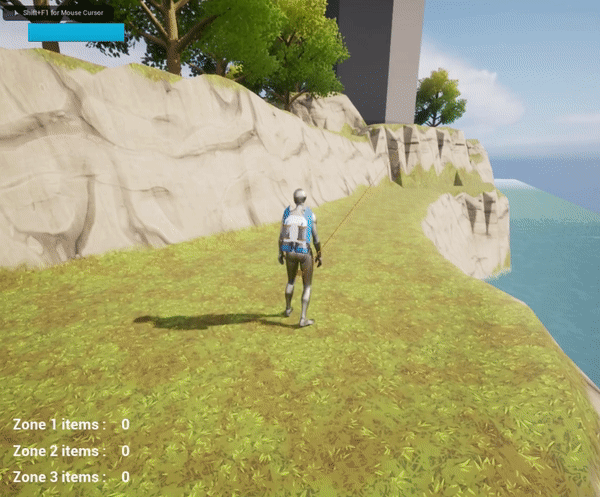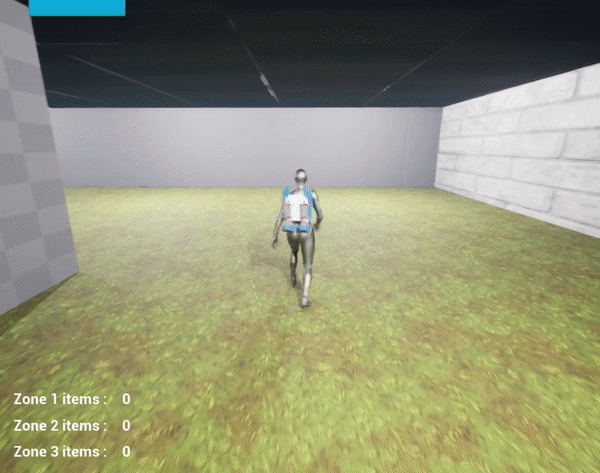PROJECT TINY OPENWORLD
ROLE
Level Designer
DESCRIPTION
This is a solo project I worked on for the Level Design 301 class and the prototyping 301 class.
The project is developed on Unreal Engine 5. This is my very first project made on Unreal Engine, so I had to go through all kinds of learning to be able to get used to the software and start a good development.
YEAR
2023 | 3rd year of study
GENRE
Adventure, Exploration, Openworld
PLATFORM
PC
SOFTWARE
Unreal Engine 5
PROTOTYPING
I coded several game mechanics to make the character more fun to control.
Jetpack & fuel system
The player can unlock a jetpack, which allows him to fly into the air to reach heights.
There is a fuel system that limits the capacity of the jetpack. The fuel automatically regenerates once the jetpack is deactivated.

Bomb system
The bomb system provides dynamic gameplay to strategically demolish walls and uncover hidden locations.
Throw the bomb, choose when to detonate it or let it detonate automatically. Catch it in mid-air to retrieve it and launch it again.

Quest items system
I implemented a system that categorizes the items collected by the player according to the zone so that he can keep track of his progress in the quest.

NPC system
I made a npc system that allows players to interact with them. They give the player quests and guide them through the world.
The player can interact with them by pressing E, after which a dialog is launched and different mechanics like jetpack and bombs can be unlocked.

LEVEL DESIGN
Top View Map
Here is the open-world map, a cohesive realm divided into three distinct zones: village, ruins, and castle, each characterized by a unique atmosphere and landmarks.
There are a multitude of paths and ways of accessing different parts of the world.
I've highlighted in yellow on the map the one to which the player is guided and which naturally leads to the final zone of the game.


Zones unveil unique mechanics : main quest in the first, jetpack in the second, and bombs in the third.
I've tried to encourage the player to revisit the spaces by incorporating puzzles using advanced mechanics at the early stages of the game.
WHAT I WAS AIMING FOR
LD Intentions
1. Creating the desire to revisit spaces
Appealing to the player's curiosity and memory
Collectable fuel orbs
Throughout the game, I've implemented orbs which, when collected, increase maximum fuel capacity, enabling the player to fly higher and longer.
Advanced gameplay elements in the first zones
The bomb is unlocked at the entrance to zone three, but walls that can be broken with it are also present in the first two zones of the game.
The idea behind these features is to make players want to return to certain places they may have visited without having unlocked the jetpack or the bomb, and reward their curiosity and exploration with an upgrade or quest items.
2. Giving each zone its own identity
Buildings & Architecture / Landmarks & Vista / Topology
Unique buildings / locations
The game features more than a dozen unique locations, spread throughout each zone, helping to give them their own identity.
Landmarks / Vista
There are several viewpoints that allow players to identify the environment and appreciate the world around them.
They can also be used to locate quest items or multiple points of interest.
The intention I wanted to achieve was that if the player remembers the zone in general, they'll remember the unique locations, landmarks, ect... and vice versa.
Areas for Further Development
1. Player Agency
The player's ability to impact the story through the game design or gameplay
- Branching storylines - Alternate quest outcomes - Consequence-driven environment
2. Dynamic Environmental Changes
The player evolves in a living world that reacts to his being
- Dynamic weather / season system - Day & night cycle - Landscapes evolving based on in-game events - Impact of player choices on the overall ecosystem
3. Enhance World Interactivity
The world is a playground with which the player can interact
- Dynamic events and encounters - Interactive environment objects - Interactive wildlife - Crafting and resource gathering
4. Emergent Gameplay
Behaviors between game systems create a unique experience for the player
- Specific / randoms conditons for events, actions... - Unexpected interactions between systems - Procedural spawn / generation
Reflections
Learning to use UE5
Biggest challenge of the project
The main difficulty of the project was to produce a good project on a totally new game engine, whether in terms of the new interface, the introduction of blueprints or the new UE-related habits and skills to be adopted.
Growth and LD skills development
Improved technically & realized the importance of concepts by having applied them
- The impact of camera distance / player FOV and the importance of the player's perception of the environment for conveying emotions or information. - The importance of a good layout and a solid "paper" design phase. - Adding a new weapon to my creative arsenal: knowledge and use of blueprints.
Areas for personnal improvement
Future goals to keep improving
Prototyping : mastering currently unused blueprint nodes, exploring optimization techniques and accessibility features, developing my UI integration skills. Level Design : Push the quality of exploration in both gameplay and environment, add a real sense of player agency and communicate more narrative or informative elements through level design.
Closing thoughts
It was fun to learn UE5
For my first experience with the engine, I'm pretty pleased with the results I've been able to achieve. I loved creating a coherent world with unique zones and elements, and I had a lot of fun learning a new software and the different notions I was able to put into practice ! I'm aware that the game isn't polished in all respects and that it lacks important immersive elements such as sound and more advanced game design/interaction, and that frustrates me, but it's important to keep in mind that this wasn't the aim of the project.